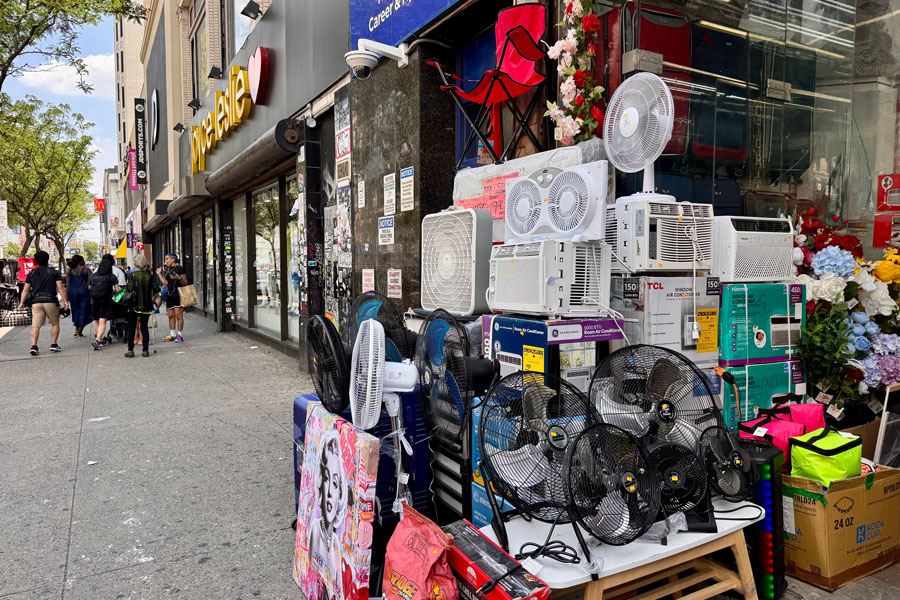Power Outages Reported Across Nassau, Suffolk By PSEG; Extreme Heat Overloads Grids, Triggers Outages Across Tri-State Area

NEW HIDE PARK, NY – Extreme heat has pushed power grids across the Tri-State area to the brink, triggering widespread outages and prompting authorities to urge residents to conserve electricity as temperatures soar. In New York City and Westchester, Con Edison reported over 6,300 customers without power, while utilities in New Jersey and Long Island experienced thousands of outages. Con Edison implemented an 8% voltage reduction in parts of Brooklyn and Queens to ease grid stress.
High demand for electricity coincides with record-breaking temperatures, with Central Park tying a 96°F high and Newark reaching 103°F, marking its hottest June day since recordkeeping began . The New York Independent System Operator (NYISO) issued an Energy Warning after capacity dipped below critical thresholds, estimating a shortfall of approximately 1,965 MW amid peak summer demand.
Wholesale electricity prices have climbed dramatically, with spot rates hitting nearly $2,400 per MWh in New York City and over $7,000 per MWh on Long Island. Grid operators raised red flags about gas turbine inefficiencies and transmission line congestion caused by the heat, but emergency measures such as tapping reserve resources and delaying non-essential maintenance have so far averted large-scale blackouts.
Heat-related outages also affected parts of Connecticut and Massachusetts. Eversource and United Illuminating reported several thousand customers without power, prompting utilities to hold off on planned maintenance and encourage conservation among consumers. In Massachusetts, assisted living facilities turned to backup generators during the outages, and local governments opened cooling centers to protect vulnerable residents.
Officials across the region have urged residents to reduce their electricity usage – suggesting thermostat settings around 76°F, postponing electric vehicle charging, and avoiding the use of large appliances during peak hours. Public cooling centers, including those in Nassau County and New York City, are staying open longer to provide relief .
Shortly after midweek, a cold front is expected to break the heat dome, bringing temperatures back to the 70s and easing pressure on the power grid . However, experts warn that such extreme heat events are becoming more frequent due to climate change, underscoring the need for long-term infrastructure upgrades to prevent system failures and protect public well-being.
Emergency Q&A for Long Islanders During the Heatwave and Power Outages
1. Which areas of Long Island are currently experiencing power outages?
Outages have been reported across Nassau and Suffolk Counties by PSEG Long Island. The most affected neighborhoods include parts of eastern Suffolk and sections of central Nassau, though specific locations vary as crews work to restore service
2. How long are outages expected to last?
Repair times vary depending on the cause—overloaded circuits versus damaged equipment. Most outages are expected to be resolved within a few hours, while larger incidents may take 12–24 hours, especially under extreme heat conditions.
3. What can I do to reduce electricity usage during peak hours?
Turn thermostats up to around 76°F, delay usage of high-energy appliances (like washers and dryers), unplug unused electronics, and postpone electric vehicle charging until off-peak hours.
4. Are there cooling centers open in Nassau and Suffolk Counties?
Yes. Both counties have activated cooling centers in community centers, libraries, and senior facilities. These locations often operate extended hours during heat emergencies—check local government websites for current listings.
5. Will schools, summer camps, or government offices close due to heat or outages?
Decisions about closures are handled locally. Some school districts have canceled afternoon sessions, and certain government offices are offering remote services or delayed openings. Check your district or local municipality’s website for specifics.
6. Could there be more widespread or rolling blackouts?
Utilities are actively managing the grid to prevent widescale blackouts through measures like voltage reduction. While small, temporary outages may occur, authorities say a region-wide shutdown is unlikely at this time.
7. Is PSEG Long Island doing enough to respond to this emergency?
PSEG has increased repair crews, implemented voltage reduction strategies, and urged conservation. However, residents are encouraged to monitor updates and report outages, as response times can vary under extreme demand.
8. What upgrades are planned to strengthen Long Island’s power grid?
Long-term solutions under discussion include updating aging transmission lines, integrating more distributed energy resources (like battery storage), expanding grid automation, and boosting capacity to handle extreme heat events.
9. Are there safety risks from low voltage or when power returns?
Lower voltage itself is generally safe, though reduced performance of appliances may occur. When power is restored, brief surges may occur—using surge protectors can help protect sensitive electronics.
10. How can I report an outage or receive service updates?
You can report outages and receive alerts on PSEG Long Island’s website or mobile app. Signing up for text or email advisories is recommended to stay informed about restoration timelines and safety notices.


